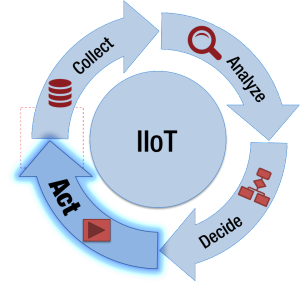Most of the talk surrounding the Industrial Internet of Things focuses on moving data upward and outward. Equally important is enabling your factory to handle incoming data.
When it comes to your factory’s ability to handle data, there are two use-cases: process improvement and process agility.
Looking first at process improvement, after completing data collection, analysis, and decision-making, the final step involves taking action. Doing this entails taking data and feeding it back into the manufacturing environment to improve the process.
 Since improvement means change, the question is: What does change require? The answer: flexibility. Manufacturing machines need to be flexible and modular so that tweaks to the production process can be implemented easily.
Since improvement means change, the question is: What does change require? The answer: flexibility. Manufacturing machines need to be flexible and modular so that tweaks to the production process can be implemented easily.
Take, for example, a beverage maker. After analyzing some data, this company recognizes a previously unknown bottleneck (no pun intended) in its process. The solution involves slightly rearranging the order of the steps in the recipe. If the responsible machine can be quickly reconfigured to handle this tweak, then everyone’s happy. However, if the change is arduous, the ROI on such a tweak diminishes rapidly.
Machine flexibility includes the network to which it is connected. Network flexibility comes in many forms. This can mean flexibility in the cabling, as in, the network should support any topology such as line, star, tree, ring, and wireless. It should also support openness and web tools. This means not just creating a machine automation network, but one to which standard Ethernet devices can also be connected. In other words: an open cable. This allows for access to acyclic data via the devices’ integrated web servers.
It should also support simple addressing. Within Profinet, logical device names can be assigned during engineering, with the PLC programming the station addresses. On the flip side, if the PLC is taught the topology of the network, it can automatically assign the station names and addresses. This is a powerful feature supporting machine flexibility. And remember, process improvement can only be achieved efficiently if the machines are modular and the network is adaptable.
The second use case to consider involves process agility. One aspect often glossed over in discussions surrounding IIoT is the good old-fashioned Internet itself. As the e-commerce industry crosses the $1.5 trillion threshold, people are becoming ever more accustomed to doing business online. It is a perfect example of data feeding into a manufacturing environment. While the objectives for this use case are different, the requirement, however, is the same: flexibility.
The oft-quoted goal of Industrie 4.0 is the ability to achieve a lot size of one. In other words, having the ability to manufacture one widget with the same efficiency as 1,000 widgets. To achieve this in modular plants, PLCs need to detect new machines or parts as fast as possible. With Profinet, the Fast Start-Up function enables the identification of stations in less than 500 ms, maximizing agility.
To further understand the importance of feeding data into the manufacturing environment, let’s look at the example of a car manufacturer. Similar to the beverage bottler, let’s say this manufacturer analyzes some Big Data and notices that sections of his line are still consuming energy even when those sections are not producing anything. While only loosely coupled to the process itself, if he were able to feed that data back into the system, he might be able to cut costs (utility bills) during those periods. With PROFIenergy, the network enables his robots to go into a sleep state similar to a laptop. When production resumes, that section of the line starts running again.
These use case scenarios should help make it clear that IIoT is not just about getting data out of plants, but also getting data back into plants. It’s a cycle. Whether the use case is improvement, agility or even energy efficiency, flexibility is a necessity. This means machine modularity coupled with network adaptability.
This article originally appeared in Automation World.
